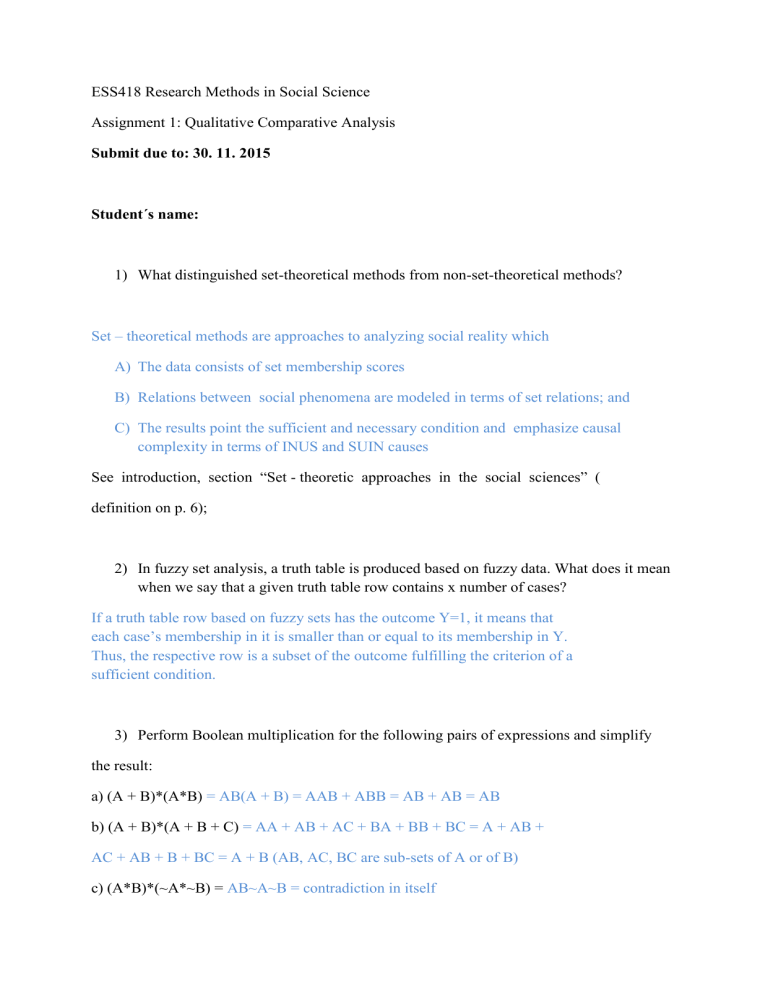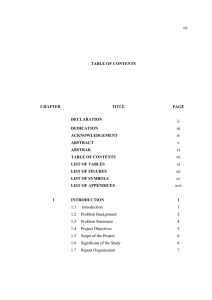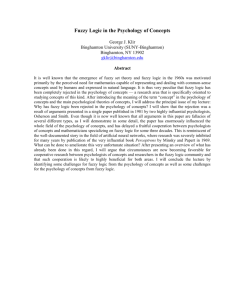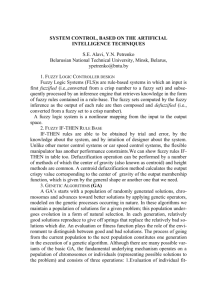ESS418 Research Methods in Social Science Assignment 1

ESS418 Research Methods in Social Science
Assignment 1: Qualitative Comparative Analysis
Submit due to: 30. 11. 2015
Student´s name:
1) What distinguished set-theoretical methods from non-set-theoretical methods?
Set – theoretical methods are approaches to analyzing social reality which
A) The data consists of set membership scores
B) Relations between social phenomena are modeled in terms of set relations; and
C) The results point the sufficient and necessary condition and emphasize causal complexity in terms of INUS and SUIN causes
See introduction, section “Set - theoretic approaches in the social sciences” ( definition on p. 6);
2) In fuzzy set analysis, a truth table is produced based on fuzzy data. What does it mean when we say that a given truth table row contains x number of cases?
If a truth table row based on fuzzy sets has the outcome Y=1, it means that each case’s membership in it is smaller than or equal to its membership in Y.
Thus, the respective row is a subset of the outcome fulfilling the criterion of a sufficient condition.
3) Perform Boolean multiplication for the following pairs of expressions and simplify the result: a) (A + B)*(A*B) = AB(A + B) = AAB + ABB = AB + AB = AB b) (A + B)*(A + B + C) = AA + AB + AC + BA + BB + BC = A + AB +
AC + AB + B + BC = A + B (AB, AC, BC are sub-sets of A or of B) c) (A*B)*(~A*~B) = AB~A~B = contradiction in itself
d) (A * (B+C))*(B * (~A + C) = (AB + AC)*(~AB + BC) = AB~AB + ABBC + AC~AB +
ACBC = ABC + ABC = ABC
4) A case has a membership of 1 set A, 0 in set B, 0.6 in set C, 0.9 in set D, and 0.1 in set
E. Calculate its membership in the following Boolean expressions: a) A + B + D = max (A, B, D) = max (1, 0, 0.9) = 1 b) (A*B) + (C*~D ) = max (A*B, C*~D) = max (min (A, B), min (C, ~D)) = max (min (A, B), min (C, 1 – D)) = max (min (1, 0), min (0.6, 1 – 0.9)) = max (min (1, 0), min (0.6, 0.1)) = max (0, 0.1) = 0.1 c) ~(A*~B + ~C + D*E) = 1 – max (A*~B, ~C, D*E) =
1 – max (min (A, ~B), ~C, min (D, E)) =
1 – max (min (A, 1 – B), 1 – C, min (D, E)) =
1 – max (min (1, 1 – 0), 1 – 0.6, min (0.9, 0.1)) =
1 – max (min (1, 1), 0.4, min (0.9, 0.1)) = 1-1 = 0 d) ~((A*~B + ~C) + (D*E )) = 1 – max (A*~B + ~C, D*E) =
1 – max (max (A*~B), ~C), min (D, E) =
1 – max (max (min (A, ~B), ~C), min (D, E) =
1 – max (max (min (A, 1 – B),1 - C), min (D, E) =
1 – max (max (min (1, 1 – 0), 0.4), min (0.9, 0.1) =
1 – max (max (min (1, 1), 0.4), 0.1) =
1 – max (max (1, 0.4), 0.1) =
1 – max (1, 0.1) =
1 – 1 =
0
5) Minimize the following primitive expressions. Are there any logically redundant prime implicants?
(A~B~C) + (A~BC) + (~A~B~C) + (~AB~C).
~B~C+ A~B + ~ AB ~ C
A~B + ~B~C + ~A~C. Yes, ~B~C is logically redundant.











